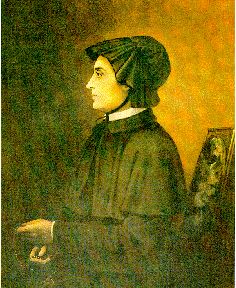Saint Elizabeth Ann Seton (1774 – 1821) signifies what America once was and, by the grace of God, may yet be again. A rich heiress and socialite, Elizabeth Ann Bayley was married at 19 to the 25-year old William Magee Seton, a businessman made wealthy in the import trade (importing, amongst many other items, the first Stradivarius to America). They were both devout Episcopalians, which are more or less American Anglicans, if that is not an oxymoron. After a downturn in their fortunes, William died of tuberculosis in Italy, where he had gone with his wife to heal, and it was here that Elizabeth was introduced to Catholicism.
Upon her return to America, Mrs. Seton, widowed now with five children, was received into the Church. To support herself and her children, she began an Academy for young girls, but many New Yorkers stayed away, mistrusting her Catholicism. So Elizabeth was invited to Maryland – at least back then, a state that was far more Catholic than New York – where with the help of the Sulpicians, she founded the Saint Joseph’s Academy and Free School, along with a new order, the Sisters of Charity of Saint Joseph. Both flourished, becoming a model of educational apostolates throughout the country (and Seton’s homeschooling method continues into our own day). ‘Mother Seton’ was renowned for her grace, learning and virtue, although she suffered much from opposition and slander, and even the death of her two daughters).
After a fruitful life well-lived, Saint Elizabeth Ann Seton died on this day, January 4th, in 1821, beatified by Pope John XXIII in 1963 (just a few months before his own death). Paul VI canonized her on September 14, 1975, as the first-born American saint (if one does not quibble that the ‘United States’ came into existence officially a few years after her birth).
Mother Seton, a symbol of America the great, and the beautiful, but a greatness and beauty that was, and is, primarily spiritual in origin, without which all is pomp and vanity. As the foundress wrote to her spiritual daughters, quoted in today’s Office, with words that we should all take to heart:
I will tell you what is my own great help. I once read or heard that an interior life means but the continuation of our Saviour’s life in us; that the great object of all his mysteries is to merit for us the grace of his interior life and communicate it to us, it being the end of his mission to lead us into the sweet land of promise, a life of constant union with himself. And what was the first rule of our dear Saviour’s life? You know it was to do his Father’s will. Well, then, the first end I propose in our daily work is to do the will of God; secondly, to do it in the manner he wills; and thirdly, to do it because it is his will.
Saint Elizabeth Ann Seton, ora pro nobis! +
(sources: WikiPedia.org; universalis.com)











